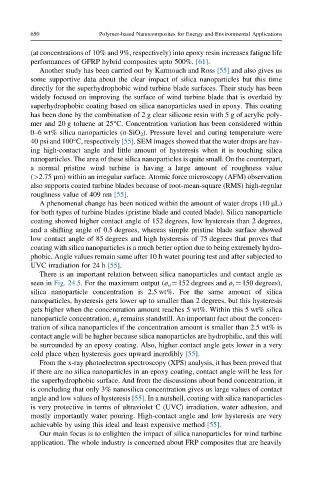Page 707 - Polymer-based Nanocomposites for Energy and Environmental Applications
P. 707
650 Polymer-based Nanocomposites for Energy and Environmental Applications
(at concentrations of 10% and 9%, respectively) into epoxy resin increases fatigue life
performances of GFRP hybrid composites upto 500%. [61].
Another study has been carried out by Karmouch and Ross [55] and also gives us
some supportive data about the clear impact of silica nanoparticles but this time
directly for the superhydrophobic wind turbine blade surfaces. Their study has been
widely focused on improving the surface of wind turbine blade that is overlaid by
superhydrophobic coating based on silica nanoparticles used in epoxy. This coating
has been done by the combination of 2 g clear silicone resin with 5 g of acrylic poly-
mer and 20 g toluene at 25°C. Concentration variation has been considered within
0–6 wt% silica nanoparticles (n-SiO 2 ). Pressure level and curing temperature were
40 psi and 100°C, respectively [55]. SEM images showed that the water drops are hav-
ing high-contact angle and little amount of hysteresis when it is touching silica
nanoparticles. The area of these silica nanoparticles is quite small. On the counterpart,
a normal pristine wind turbine is having a large amount of roughness value
(>2.75 μm) within an irregular surface. Atomic force microscopy (AFM) observation
also supports coated turbine blades because of root-mean-square (RMS) high-regular
roughness value of 409 nm [55].
A phenomenal change has been noticed within the amount of water drops (10 μL)
for both types of turbine blades (pristine blade and coated blade). Silica nanoparticle
coating showed higher contact angle of 152 degrees, low hysteresis than 2 degrees,
and a shifting angle of 0.5 degrees, whereas simple pristine blade surface showed
low contact angle of 85 degrees and high hysteresis of 75 degrees that proves that
coating with silica nanoparticles is a much better option due to being extremely hydro-
phobic. Angle values remain same after 10 h water pouring test and after subjected to
UVC irradiation for 24 h [55].
There is an important relation between silica nanoparticles and contact angle as
seen in Fig. 24.5. For the maximum output (ø a ¼152 degrees and ø r ¼150 degrees),
silica nanoparticle concentration is 2.5 wt%. For the same amount of silica
nanoparticles, hysteresis gets lower up to smaller than 2 degrees, but this hysteresis
gets higher when the concentration amount reaches 5 wt%. Within this 5 wt% silica
nanoparticle concentration, ø a remains standstill. An important fact about the concen-
tration of silica nanoparticles if the concentration amount is smaller than 2.5 wt% is
contact angle will be higher because silica nanoparticles are hydrophilic, and this will
be surrounded by an epoxy coating. Also, higher contact angle gets lower in a very
cold place when hysteresis goes upward incredibly [55].
From the x-ray photoelectron spectroscopy (XPS) analysis, it has been proved that
if there are no silica nanoparticles in an epoxy coating, contact angle will be less for
the superhydrophobic surface. And from the discussions about bond concentration, it
is concluding that only 3% nanosilica concentration gives us large values of contact
angle and low values of hysteresis [55]. In a nutshell, coating with silica nanoparticles
is very protective in terms of ultraviolet C (UVC) irradiation, water adhesion, and
mostly importantly water pouring. High-contact angle and low hysteresis are very
achievable by using this ideal and least expensive method [55].
Our main focus is to enlighten the impact of silica nanoparticles for wind turbine
application. The whole industry is concerned about FRP composites that are heavily

